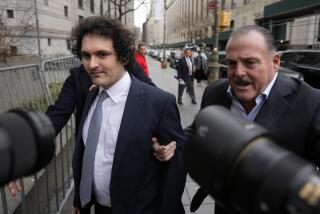U.S. to sell its shares of Citigroup
- Share via
Reporting from New York — The Treasury Department intends to cash in its shares of Citigroup Inc. in a move that could result in an $8-billion profit for the government, based on the banking giant’s closing price Monday.
The federal agency said it would begin selling its 7.7 billion shares -- which amounts to about 27% of the company -- acquired during the financial bailout of late 2008.
Citi shares closed at $4.18, down 13 cents or 3% on Monday.
The Citigroup bailout was among the most extensive and complicated of the deals under the Troubled Asset Relief Program because of the bank’s heavy involvement in troubled mortgage-backed securities.
The first infusion of capital came in October 2008 and amounted to $20 billion. In December, with the bank still ailing, the government gave it an additional $25 billion.
To help Citigroup’s balance sheet, the government agreed to turn that second cash infusion into common shares.
Given that a single quick sale could cause a sharp drop in Citigroup’s stock price, the Treasury Department is planning to sell the shares slowly with the help of investment bank Morgan Stanley.
“Treasury intends to sell its Citigroup common shares into the market through various means in an orderly and measured fashion,” the department said Monday.
The government decided not to sell the shares late last year because of continuing concerns about Citigroup’s health. Since then, the company’s share price has risen steadily, and the decision to sell now is viewed as a vote of confidence in the company.
“The government is an insider. If it thought Citi or the financial system was on the verge of collapse, it would not be selling,” said David G. Dietze, the president of Point View Financial Services, in a note to clients.
The sale will be the latest transaction in which the government is set to make a profit from of its investments in the big banks during the financial crisis. Earlier this month, the government made more than $1 billion from the sale of Bank of America Corp. warrants.
At the time of the bailout, many financial experts questioned whether the government would ever see the money again.
“We didn’t know whether it would work,” said Bill Mutterperl, an attorney specializing in corporate law at law firm Reed Smith, “but it turns out that it worked better than anybody anticipated.”
Of the 707 financial institutions that the government helped through TARP, 62 had made full repayment as of Wednesday.
Among those were several big banks that received the majority of the TARP funds, including Wells Fargo and JPMorgan Chase & Co., as well as Bank of America.
The profits made from the infusions of capital into banks are not likely to make up for losses in other parts of TARP, however.
This month, the Treasury Department estimated that it would eventually lose $117 billion of the $550 billion it will spend over the life of TARP. The biggest losses -- $48 billion -- are expected to come from investments in insurance giant AIG.
The government also still has ownership in many smaller banks that have not paid the government back.
TARP was initially designed in the fall of 2008 to purchase toxic assets from the banks. It was soon altered and the money was used to give the banks capital infusions in return for preferred shares.
Close to $250 billion has been injected into the banks through the program.
nathaniel.popper@
latimes.com
More to Read
Inside the business of entertainment
The Wide Shot brings you news, analysis and insights on everything from streaming wars to production — and what it all means for the future.
You may occasionally receive promotional content from the Los Angeles Times.









